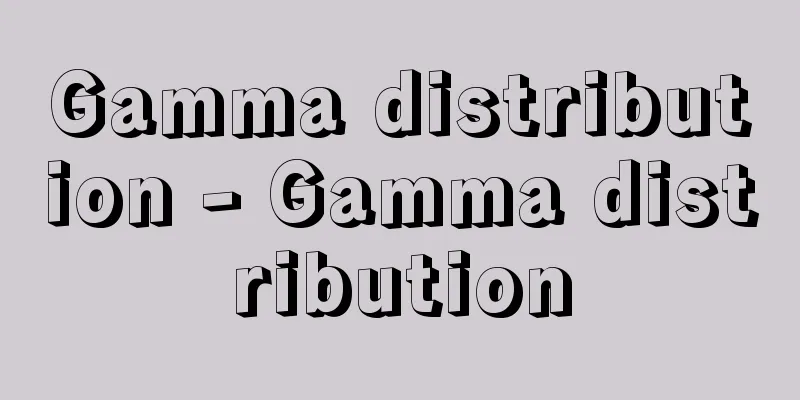DNA

|
The common name for deoxyribonucleic acid. DNA is the abbreviation for the English term DeoxyriboNucleic Acid. DefinitionA polymeric compound in which 2-deoxyribonucleotides are polymerized in a linear chain via phosphodiester bonds between the 3' and 5' ends. Nucleic acids include DNA and RNA (ribonucleic acid). Nucleic acids are one of the polymeric compounds that make up living organisms along with proteins, carbohydrates, lipids, etc. The genes of almost all living organisms are made of DNA, but there are some viruses whose genes are made of RNA. [Kikuchi Takahiko] Discovery of DNAIn the late 1860s, organic chemist Friedrich Miescher (1844-1895), who worked in Basel, Switzerland, believed that compounds in the cell nucleus were important. He collected gauze and bandages stained with pus from hospitals, and discovered a new highly acidic compound from the pus of dead white blood cells (especially those with large nuclei). He named this compound nuclein and announced its discovery in 1867. Nuclein contains the elements C (carbon), H (hydrogen), N (nitrogen), and O (oxygen), as well as a large amount of P (phosphorus). A similar substance was also detected in salmon testes (sperm also have a large proportion of nuclei). Since salmon lose muscle and increase sperm while migrating up the Rhine, Miescher thought that muscle proteins had changed, and probably named it "nuclein" with the specific protein in the nucleus in mind. In 1889, the German organic chemist Richard Altmann (1852-1900) determined that this was a new polymeric compound different from proteins, and renamed it "nucleic acid." [Kikuchi Takahiko] Components of DNACompared to other biopolymers (proteins, carbohydrates, lipids, etc.), the components of nucleic acids are extremely simple, consisting of four types of 2'-deoxyribonucleotides, namely adenylic acid, guanylic acid, cytidylic acid, and thymidylic acid, which are polymerized together. Each of the four types of 2'-deoxyribonucleotides has one phosphate group and one molecule of a different base, adenine (A), guanine (G), cytosine (C), or thymine (T), attached to 2'-deoxyribose. DNA is polymerized in a linear form with a phosphodiester bond between the 3'-OH and 5'-OH of 2'-deoxyribose via phosphate. Adenine and guanine are bases with a purine ring, while cytosine and thymine are bases with a pyrimidine ring. Due to the simplicity of their structure, the analysis of their biological function was delayed, and they were thought to simply serve as a support for proteins in the nucleus. In particular, the tetranucleotide hypothesis, a structure based on four nucleotide units published by P. A. T. Levin (Fabus Levine) in 1912, became influential, and research into biological functions was delayed. [Kikuchi Takahiko] DNA is GenesIn 1928, Frederick Griffith (1879-1941) discovered that there was a substance that could change the genetic properties of streptococci (pneumococci), and called this the transforming principle. In 1944, O. T. Avery, Colin Munro MacLeod (1909-1972), and Maclyn MacCarty (1911-2005) found that when purified DNA was mixed directly with bacteria, the bacterial properties changed. Furthermore, this transforming activity was not affected by protease, but was completely lost when treated with DNA enzyme, suggesting that the substance that was transforming was DNA. However, this discovery was not widely accepted at the time, and it was the experiment by A. D. Hershey and M. Chase published in 1952 that finally led to the general acceptance that genes are DNA. To settle the debate over whether genes are DNA or proteins, they used the T2 bacteriophage (a type of virus, abbreviated as T2 phage) that infects E. coli. The T2 phage is composed only of protein and DNA, and when it infects E. coli, it multiplies 100-fold in just a dozen minutes, producing baby phages. They labeled the protein of this phage with the radioactive isotope S 35 and the DNA with P 32 , and measured what would happen to each of the labeled compounds after it infected E. coli. They put the E. coli immediately after the phage was adsorbed in a mixer and then collected the E. coli using a centrifuge. 80% of the S 35 label did not coexist with the E. coli, while 80% of the P 32 remained in the E. coli. When the collected bacteria were cultured in a new medium, baby T2 phages were produced, in which 30% of P 32 was recovered and less than 1% of S 35 was recovered. From this result, they inferred that the gene for producing phages is probably DNA. This experiment led to the widespread idea that the genetic information that makes up baby phages is found in DNA, not proteins. [Kikuchi Takahiko] Higher-order structure of DNATo prove that DNA is a gene, it is necessary to show how copies are made. In 1951, L.C. Pauling proposed the α (alpha)-helix as the basic structure of proteins based on the results of X-ray crystallography, which showed that the function of proteins can be understood. It was thought that DNA probably required some higher-order structure to function as a genetic material, and in 1953, J.D. Watson and F.H.C. Crick, along with M.H.F. Wilkins (and R.E. Franklin), who were conducting X-ray crystallography of DNA, announced the double helix model of DNA (two helices are also possible). This model, based on X-ray crystallography, estimated that (1) DNA has a periodic helical structure, (2) the diameter of the helix is 2 nanometers (20 angstroms), with two parallel helices that run in opposite directions along the long axis, (3) the bases are spaced 0.34 nanometers (3.4 angstroms) apart, and (4) the period of the helix is 3.4 nanometers (34 angstroms), corresponding to 10 bases. Based on the chemical properties of DNA, it was also suggested that the phosphate groups are on the outside of the molecule, and that the two helices are stably maintained by hydrogen bonds between the bases. The helix diameter of 2 nanometers indicates that this size is achieved by combining pyrimidines and purines, and that optimal hydrogen bonds are formed by complementary base pairs of A and T and G and C. Incidentally, E. Chargaff analyzed the base composition of various DNAs and based on the results proposed "Chargaff's rule," which states that the amounts of adenine (A) and thymine (T), and guanine (G) and cytosine (C) in DNA are approximately equal, and the double helix model also explains "Chargaff's rule." The most basic method for genes to be copied is also explained by this double helix model of DNA. If two helices are split into two and DNA synthesis occurs by forming complementary base pairs with each other, an identical copy of the original DNA will be created. The correctness of this replication mechanism was proven in 1958 by experiments by Meselson (1930- ) and Stahl (1929- ), who proposed a semi-conservative DNA replication model. [Kikuchi Takahiko] DNA ReplicationFor DNA to function as a gene, it must be copied (replicated) accurately. In 1956, A. Kornberg purified DNA polymerase from an extract of E. coli, an enzyme that uses DNA as a template to replicate DNA with the same sequence. This enzyme has the following characteristics: (1) it synthesizes a complementary DNA strand using DNA as a template, (2) it uses four types of 2-deoxyribonucleoside triphosphates (dATP, dGTP, dCTP, TTP) as substrates and releases pyrophosphate, (3) it requires ATP and Mg2 + , (4) a primer with a 3'-OH (a short nucleotide that provides a 3'-OH for the synthesis of the first nucleotide) is required to start DNA synthesis, and (5) synthesis only occurs in the 5' to 3' direction. Based on this, in 1967 (Showa 42), molecular biologist Okazaki Reiji (1930-1975) and his colleagues published a model in which DNA replication occurs only discontinuously, passing through Okazaki fragments (DNA fragments discovered by Okazaki Reiji) as replication intermediates. Furthermore, in 1975, Okazaki and his colleagues discovered that primers are short RNAs. In DNA replication by viruses and bacteriophages, hydroxyl groups in amino acids in proteins are sometimes used as primers for DNA replication. [Kikuchi Takahiko] DNA transcriptionDNA, which is a gene, not only transmits genetic information to offspring, but also has the mission of producing all the RNA and proteins that make up our own cells. In particular, F. Jacob and J. L. Monod predicted, as a natural consequence of their operon theory published in 1960 (which unified the mechanism by which genes are expressed and protein synthesis is regulated), that short-lived RNA that copies (replicates) DNA information exists as an intermediate in protein synthesis, and named this intermediate messenger RNA (mRNA). Thus, Crick proposed the central dogma that the genetic information of DNA is transcribed from DNA to RNA and translated into proteins. [Kikuchi Takahiko] The state of DNA in the nucleusThe size of intracellular DNA varies depending on the species, but even the smallest independently living mycoplasma has a DNA length of 5.8 × 107 base pairs, which is extremely long considering that the length of the Watson-Crick B-type DNA is 20 mm in a linear form, while the bacterial body is only about 1 micrometer. In eukaryotes, the number of base pairs is 3× 109 in humans, and if all of them were connected together, it would reach about 1 meter. The size of the nucleus is at most 10 micrometers, and DNA is divided into 23 chromosomes, each packed in 23 pairs of two. To keep the length small, DNA is folded in a very regular pattern. The most basic and smallest unit is the nucleosome, which is an octamer of four types of histones ( H2A , H2B , H3 , and H4 ) with two of each, and 200 base pairs of DNA wrapped around it twice. Nucleosomes are further folded into coils to form chromosomes. During cell division, the degree of condensation of chromosomes increases further, and they become metaphase chromosomes, which can be observed under a microscope with a characteristic shape, and are distributed to two daughter cells. [Kikuchi Takahiko] DNA topologyThe DNA structure shown by Watson and Crick is called type B, and the existence of a slightly different right-handed helical structure called type A has also been revealed. This type A structure is the typical structure that RNA takes when forming a double helix. In 1979, Alexander Rich (1924- ) and his colleagues focused on the possibility that DNA may take a left-handed structure. This structure is called type Z, but its existence in cells and its role have not been clarified. The chromosomal DNA, plasmids, and viral DNA of many prokaryotes (bacteria and archaea) are not linear, but have a circular structure with both ends covalently bonded. In 1963, Roger Weil and American Jerome Vinograd (1913-1976) extracted polyomavirus DNA from cells and suggested that the DNA double helix had a circular structure, which was a superhelical structure in which the DNA double helix was further helical. In 1971, James C. Wang (1936- ) discovered DNA topoisomerase, which can eliminate superhelical structures, and in 1976, Martin Gellert (1929- ) discovered DNA gyrase, which can introduce superhelical structures. These enzymes are widely distributed in both eukaryotes and prokaryotes, and are essential for DNA copying (replication) and transcription, so antibacterial and anticancer drugs that target them have been developed. [Kikuchi Takahiko] DNA modification of genesSince DNA is the body of genes, many attempts have been made to change genetic information by directly adding DNA to cells. Since the discovery of DNA-mediated transformation of streptococci, it has become possible to manipulate various cells to incorporate DNA by slightly modifying them (genetic engineering), thereby changing the genetic information of the cells. However, there have been no reports of DNA being incorporated into an individual and affecting the genetic information when it is ingested as part of a normal diet. Although nucleic acids are important components for living organisms, they do not have to be ingested as food, unlike other nutrients, proteins, carbohydrates, and lipids. Because nucleic acids are so important for the maintenance of life, living organisms are able to synthesize the components of nucleic acids themselves from other nutrients (amino acids and sugars), and nucleic acid deficiency is extremely rare. Furthermore, it is not thought that ingesting nucleic acids as part of one's diet will improve one's health or abilities, and conversely, it has been pointed out that ingesting large amounts of nucleic acids can cause uric acid to accumulate in the body as a decomposition product of the purine that is a component of nucleic acids, leading to gout. [Kikuchi Takahiko] "The Adventure of DNA - From Double Helix to Superhelix" by Kikuchi Takahiko (1993, Iwanami Shoten)" ▽ "Future Biological Science Series 35: How DNA Folds and Works" by Konda Fumio, edited by Oshima Yasuo et al. (1996, Kyoritsu Shuppan)" ▽ "Why Do Genes Coil? - The Three-Dimensional Structure and Function of DNA" by C.R. Carradine and Horace R. Drew, translated by Watt Fujiko and Nishimura Yoshifumi (1996, Kyoritsu Shuppan)" ▽ "Tackling the Mysteries of DNA - A Century of Genetic Research" by Watanabe Masataka (1998, Asahi Shimbun)" ▽ "Why Does DNA Not Tangle?," edited by Nicholas Wade, supervised by Nakamura Keiko, translated by Translation Workshop Kotodama (2000, Shoeisha)" ▽ "The Mysteries of Morphology and Evolution Revealed by DNA" by Sean B. Carroll and Jennifer K. Grenier, translated and supervised by Ueno Naoto and Noji Sumiharu (2003, Yodosha)" ▽ "Lincoln's Adventures in DNA and Genetics" vols. 1-2 by Philip R. Reilly, translated by Takano Toshiya (2003, Iwanami Shoten) " ▽ "DNA and Proteins: Molecules that Determine the Uniqueness of Living Things" by Ishii Shinichi (2006, Shokabo) ▽ "Molecular Biology of Genes, 5th Edition, by J.D. Watson et al., translated by Nakamura Keiko et al. (2006, Tokyo Denki University Press)" ▽ "Essential Genes" by B. Lewin, translated by Kikuchi Takahiko et al. (2007, Tokyo Kagaku Dojin)" ▽ "Watson's Molecular Biology of Recombinant DNA: Genes and Genomes, 3rd Edition (2009, Maruzen)" by James D. Watson et al., supervised translation by Michio Matsuhashi, Masao Yamada, Masao Hyodo, and Dai Ayuzawa" ▽ "Hartwell Genetics, 3rd Edition (2010, MEDSI)" by L. Hartwell et al., supervised translation by Yoshihiko Kikuchi" ▽ "An Introduction to DNA Science: The Dynamic Double Helix of Life" by Mitsuhiro Yanagida" ▽ "An Invitation to Molecular Evolution: The History of Life Hidden in DNA" by Takashi Miyata" ▽ "DVD & Illustrations: A Visual Guide to the Function of DNA" by Mitsuko Kudo and Keiko Nakamura (all published by Kodansha Bluebacks)" ▽ "DNA and Genetic Information" by Kin'ichiro Miura (Iwanami Shinsho)" ▽ "An Introduction to Life Sciences from the Original Texts" by Yojiro Kimura (Kodansha Academic Library)" ▽ "The Double Helix" by J.D. Watson, translated by Fujio Egami and Keiko Nakamura (Kodansha Bunko) [References] | | | | | | | | | | | | | | | | | | | | | | | | | | | | | | | | | | | |©Shogakukan "> Chemical structure of DNA ©Shogakukan "> Watson-Crick model of DNA Source: Shogakukan Encyclopedia Nipponica About Encyclopedia Nipponica Information | Legend |
|
デオキシリボ核酸の通称。デオキシリボ核酸の英語表記DeoxyriboNucleic Acidの頭文字を並べてDNAとした。 定義2-デオキシリボヌクレオチド(2'deoxyribonucleotide)が、3'-5'間のフォスフォジエステル結合で、直鎖状に重合した高分子化合物。核酸には、DNAとRNA(リボ核酸RiboNucleic Acid)とが含まれる。核酸は、タンパク質、糖質、脂質などとともに生物体を構成している高分子化合物の一つである。ほとんどすべての生物の遺伝子は、DNAでつくられているが、ウイルスのなかにはRNAを遺伝子としているものが若干存在する。 [菊池韶彦] DNAの発見1860年代の後半、スイスのバーゼルに在任していた有機化学者ミーシャーFriedrich Miescher(1844―1895)は、細胞核内にある化合物を重要と考え、病院から、膿(うみ)で汚れたガーゼや包帯を集め、白血球(とくに核が大きい)の死骸である膿から、新しい強酸性の化合物を発見し、これにヌクレインnucleinと名前をつけ、1867年に発表した。ヌクレインは、C(炭素)、H(水素)、N(窒素)、O(酸素)の元素を含むほかに大量のP(リン)を含んでいた。同様の物質はサケ(マス)の精巣(精子もまた核の占める割合が大きい)からも検出することができた。サケは、ライン川を遡(さかのぼ)ってくる間に、筋肉が減り、精子が増えていることから、ミーシャーは筋肉のタンパク質が変化したものと考え、おそらく核にある特有のタンパク質を意図して「Nuclein」と名づけたと考えられる。1889年に、ドイツの有機化学者アルトマンRichard Altmann(1852―1900)は、これはタンパク質とは異なる新奇な高分子化合物だとし、新たに「核酸Nucleic Acid」と命名し直した。 [菊池韶彦] DNAの構成成分ほかの生体高分子化合物(タンパク質、糖質、脂質など)に比べて、核酸の構成成分はきわめて単純であり、4種の2'-デオキシリボヌクレオチドすなわち、アデニル酸、グアニル酸、シチジル酸、チミジル酸が重合したものである。4種の2'-デオキシリボヌクレオチドは、リン酸基1分子と2'-デオキシリボースにそれぞれ異なる塩基、アデニン(A)、グアニン(G)、シトシン(C)、チミン(T)のいずれかが1分子ついている。DNAは2'-デオキシリボースの3'-OHと5'-OH間がリン酸によりフォスフォジエステル結合で直鎖状に重合している。アデニンとグアニンはプリン環をもつ塩基であり、シトシンとチミンはピリミジン環をもつ塩基である。こうした構成の単純さから、生物学的な機能の解析は遅れ、単に核内のタンパク質の支持体と考えられていた。とくに、P・A・T・レビン(フェーブス・レビーン)が1912年に発表した四つのヌクレオチドを単位とした構造、テトラヌクレオチドTetranucleotide仮説が有力となり、生物学的な機能の研究は遅れることになった。 [菊池韶彦] DNAは遺伝子である1928年にグリフィスFrederick Griffith(1879―1941)は連鎖状球菌(肺炎双球菌)の形質(遺伝的な性質)を変えることのできる物質があることを発見し、これを形質転換物質transforming principleとよんだ。1944年にO・T・エーブリー(アベリー)、マクラウドColin Munro MacLeod(1909―1972)、マッカーティーMaclyn MacCarty(1911―2005)の3人により、細菌に精製したDNAを直接混ぜると、細菌の形質が変わること、さらにこの形質転換の活性は、タンパク分解酵素によっては影響されず、DNA分解酵素で処理すると、完全に失われることから、形質転換を行っている物質はDNAであろうと示唆された。しかし、当時この発見も広くは受け入れられずに、最終的に遺伝子はDNAであるということが一般的に認められるようになったのは、1952年に発表されたA・D・ハーシェイとM・チェイスによる実験である。彼らは、遺伝子がDNAかタンパク質かという議論に決着をつけるために、大腸菌に感染するT2バクテリオファージ(ウイルスの一種、T2ファージと略称する)を使用した。T2ファージは、タンパク質とDNAのみから構成されており、大腸菌に感染させると、十数分のうちに100倍にも増殖し、子供のファージをつくる。このファージのタンパク質を放射性同位元素S35、DNAをP32で標識し、大腸菌に感染後それぞれの標識された化合物がどうなるかを測定した。ファージが吸着した直後の大腸菌をミキサーにかけたのち、遠心分離器で大腸菌を集めると、S35の標識の80%は大腸菌とは共存せず、逆にP32の80%は大腸菌にとどまっており、この集めた菌体を新しい培地で培養すると子供のT2ファージが生産され、そこには30%のP32が回収され、S35は1%以下であった。この結果から、ファージをつくるための遺伝子はDNAであろうと推論した。この実験から、子供のファージをつくっている遺伝情報はタンパク質ではなくDNAにあるという考え方が広まるようになった。 [菊池韶彦] DNAの高次構造DNAが遺伝子であることを示すには、どのようにコピー(複製)がつくられるかということを示す必要がある。1951年にL・C・ポーリングはX線結晶解析の結果をもとにタンパク質の基本的な構造として、α(アルファ)-へリックスを提案し、これにより、タンパク質の機能が理解できることを示した。おそらくDNAも遺伝物質としての機能のためには何らかの高次構造がかかわるものと考え、J・D・ワトソンとF・H・C・クリック、それにDNAのX線結晶解析を進めていたM・H・F・ウィルキンズ(とR・E・フランクリン)により、1953年にDNAの二重螺旋モデル(にじゅうらせんもでる)が発表された。このモデルは、X線結晶解析から、(1)DNAの構造には周期性のある螺旋構造がある、(2)螺旋の直径は2ナノメートル(20オングストローム)で長軸方向に互いに逆向きになる2本の螺旋が並行している、(3)塩基は0.34ナノメートル(3.4オングストローム)の間隔にある、(4)螺旋の周期は3.4ナノメートル(34オングストローム)で塩基10個に相当する、と推定した。また、DNAの化学的性質から、リン酸基は分子の外側にあり、2本の螺旋は塩基間の水素結合により安定に維持されていると考えられた。螺旋の直径が2ナノメートルになることから、ピリミジンとプリンを組み合わせるとこの大きさになり、AとT、GとCの相補的な塩基対により最適な水素結合がつくられることが示された。ちなみに、E・シャルガフはさまざまなDNAの塩基組成を解析し、その結果からDNAのアデニン(A)とチミン(T)、グアニン(G)とシトシン(C)の量はほぼ等しいとする「シャルガフの通則」を提唱していたが、二重螺旋モデルは「シャルガフの通則」をも説明していた。 遺伝子としての、コピーされるためのもっとも基本的な方法も、このDNAの二重螺旋モデルで説明される。2本の螺旋が二つに分かれ、それぞれに対して相補的な塩基対をつくってDNA合成が起これば、もとのDNAとまったく同一のものがつくられることになるからである。この複製機構が正しいことは、1958年にメセルソンMatthew Stanley Meselson(1930― )とスタールFranklin William Stahl(1929― )による実験で証明され、半保存的なDNA複製のモデルが提案された。 [菊池韶彦] DNAの複製DNAが遺伝子としての役割を果たすためには、正確にコピー(複製)されなければならない。1956年にA・コーンバーグは大腸菌の抽出液から、DNAを鋳型として同じ配列をもったDNA複製をする酵素DNAポリメラーゼを精製した。この酵素は、(1)DNAを鋳型として相補性をもったDNA鎖を合成する、(2)4種の2-デオキシリボヌクレオシド三リン酸(dATP、dGTP、dCTP、TTP)を基質とし、ピロリン酸を遊離する、(3)ATPとMg2+が必須である、(4)DNA合成開始には3'-OHをもったプライマーprimer(最初のヌクレオチド合成が起こるために3'-OHを提供する短いヌクレオチド)が必要である、(5)合成の方向は5'から3'の方向にしか起こらない、という特徴をもっていた。このことから、1967年(昭和42)には分子生物学者の岡崎令治(おかざきれいじ)(1930―1975)らは、DNA複製は不連続にしか起こらず、複製中間体として岡崎フラグメント(岡崎令治が発見したDNA断片)を経由するというモデルを発表した。さらに1975年に岡崎令治らは、プライマーは短いRNAであることを発見した。なお、ウイルスやバクテリオファージのDNA複製では、DNA複製のプライマーとしてはタンパク質中のアミノ酸にあるヒドロキシ基が使われることもある。 [菊池韶彦] DNAの転写遺伝子であるDNAは、遺伝情報を子孫に伝えるだけでなく、自分自身の細胞を構成するすべてのRNAとタンパク質をつくりだす使命を担っている。とくにF・ジャコブとJ・L・モノーは、1960年に発表したオペロン説(遺伝子が発現してタンパク質の合成が調節される仕組みを統一的に示した)の当然の帰結として、タンパク質の合成にはDNAの情報をコピー(複製)した寿命の短いRNAが中間体として存在することを予測し、この中間体をメッセンジャーRNA(mRNA)と命名した。こうしてDNAの遺伝情報は、DNAからRNAに転写され、タンパク質に翻訳されるというセントラルドグマcentral dogmaがクリックにより提唱された。 [菊池韶彦] 核内でのDNAの状態細胞内のDNAの大きさは、生物種によってさまざまであるが、独立して生活をしている最小のマイコプラズマでも、そのDNAは5.8×107塩基対もある。これは、ワトソン-クリックによるB型のDNAの長さは直鎖状として20ミリメートルになり、菌体がせいぜい1マイクロメートル程度であることから考えると、非常に長い。 一方、真核生物では、ヒトの場合、3×109塩基対で、全部つなぎ合わせると約1メートルに達する。核の大きさはせいぜい10マイクロメートルで、DNAはこのなかに23本の染色体に分かれそれぞれが2本ずつ23対詰め込まれている。その長さを小さくまとめるため、DNAは非常に規則正しく折りたたまれている。もっとも基本的な最小単位はヌクレオソームで、これは4種のヒストン(H2A、H2B、H3、H4)が、それぞれ二つずつ8量体となり、それに200塩基対のDNAが2巻きに巻きついている。ヌクレオソームは、さらにコイル状に折りたたまれ、染色体を構成している。細胞分裂期になると、染色体の凝縮の度合いはさらに増し、顕微鏡下で特徴的な形態が観察できる分裂中期染色体metaphase chromosomeとなり、それぞれ二つの娘細胞に分配される。 [菊池韶彦] DNAトポロジーワトソンとクリックが示したDNAの構造はB型とよばれる構造で、ほかにもA型という若干異なる右巻きの螺旋構造の存在も明らかにされている。このA型の構造は、RNAが二重螺旋をつくるときにとる典型的な構造である。1979年にリッチAlexander Rich(1924― )らは、DNAが左巻きの構造をとる可能性に注目した。この構造はZ型とよばれているが、細胞内での存在や、その役割は明らかにされていない。 多くの原核生物(細菌、古細菌)の染色体DNAやプラスミド、ウイルスのDNAは直鎖状ではなく、その両端が共有結合をした環状構造をとっている。1963年にワイルRoger WeilとアメリカのビノグラドJerome Vinograd(1913―1976)が細胞から抽出したポリオーマウイルスのDNAは環状で、DNAの二重螺旋がさらに螺旋構造をとった超螺旋構造をしていることを示唆した。1971年にはワンJames C. Wang(1936― )により超螺旋構造を解消するDNAトポアイソメレース(DNAtopoisomerase)、1976年にはゲラートMartin Gellert(1929― )により、超螺旋を導入するDNAジャイレース(DNAgyrase)が発見された。これらの酵素は、真核生物、原核生物を問わず、広く分布しており、DNAのコピー(複製)、転写に際しては必須であるため、これを標的とした抗菌剤や抗癌剤(こうがんざい)が開発されている。 [菊池韶彦] DNAによる遺伝子の改変DNAは遺伝子の本体であることから、細胞に直接DNAを加えることにより、遺伝情報を変える試みが多くなされてきた。DNAによる連鎖状球菌の形質転換法の発見以来、さまざまな細胞に若干の処理を施して(たとえば、細胞膜の透過性を高めたり、直接穴をあけたりする)DNAを取り込ませて、細胞の遺伝情報を変える操作(遺伝子工学)が可能になっている。しかし、通常の食事の一部としてDNAを摂取しても、DNAが個体に取り込まれて、遺伝情報にかかわるという報告はない。 核酸は生物にとって重要な成分であるが、ほかの栄養素、タンパク質、糖質、脂質のように、食料として摂取しなければならないことはない。生物にとっては、核酸は生命の維持にとって重要だからこそ、ほかの栄養素(アミノ酸や糖)から核酸の構成成分を自ら合成できるようになっており、核酸欠乏症はきわめて稀(まれ)である。ましてや、核酸を食事として摂取したからといって健康状態や能力が改善することは考えられず、逆に、多量の核酸を摂取すると、その成分であるプリンの分解産物として尿酸が体内に蓄積して痛風(つうふう)の原因となることも指摘されている。 [菊池韶彦] 『菊池韶彦著『DNAの冒険――二重らせんから超らせんへ』(1993・岩波書店)』▽『大島泰郎他編、今本文男著『未来の生物科学シリーズ35 DNAはどのように折れ畳まれて働くか』(1996・共立出版)』▽『C・R・カラダイン、ホレース・R・ドゥルー著、ワット富士子・西村善文訳『なぜ遺伝子はらせんを巻くのか――DNAの立体構造と機能』(1996・共立出版)』▽『渡辺政隆著『DNAの謎に挑む――遺伝子探求の一世紀』(1998・朝日新聞社)』▽『ニコラス・ウェイド編、中村桂子監修、翻訳工房ことだま訳『DNAのらせんはなぜ絡まらないのか』(2000・翔泳社)』▽『ショーン・B・キャロル、ジェニファー・K・グルニエ著、上野直人・野地澄晴監訳『DNAから解き明かされる形づくりと進化の不思議』(2003・羊土社)』▽『フィリップ・R・レイリー著、高野利也訳『リンカーンのDNAと遺伝学の冒険』1~2(2003・岩波書店)』▽『石井信一著『DNAとタンパク質――生物の特異性を決める分子たち』(2006・裳華房)』▽『J・D・ワトソン他著、中村桂子他訳『遺伝子の分子生物学』第5版(2006・東京電機大学出版局)』▽『B・ルーウィン著、菊池韶彦他訳『エッセンシャル遺伝子』(2007・東京化学同人)』▽『ジェームズ・D・ワトソン他著、松橋通生・山田正夫・兵頭昌雄・鮎沢大監訳『ワトソン組換えDNAの分子生物学――遺伝子とゲノム』第3版(2009・丸善)』▽『L・ハートウェル他著、菊池韶彦監訳『ハートウェル遺伝学』第3版(2010・MEDSI)』▽『柳田充弘著『DNA学のすすめ――躍動する生命の二重らせん』』▽『宮田隆著『分子進化学への招待――DNAに秘められた生物の歴史』』▽『工藤光子・中村桂子著『DVD&図解 見てわかるDNAのしくみ』(以上講談社ブルーバックス)』▽『三浦謹一郎著『DNAと遺伝情報』(岩波新書)』▽『木村陽二郎著『原典による生命科学入門』(講談社学術文庫)』▽『J・D・ワトソン著、江上不二夫・中村桂子訳『二重らせん』(講談社文庫)』 [参照項目] | | | | | | | | | | | | | | | | | | | | | | | | | | | | | | | | | | | |©Shogakukan"> DNAの化学構造 ©Shogakukan"> DNAのワトソン‐クリックモデル 出典 小学館 日本大百科全書(ニッポニカ)日本大百科全書(ニッポニカ)について 情報 | 凡例 |
>>: TAT - Thematic Apperception Test
Recommend
growth formula
…The growth curve of a population also shows vari...
Second Empire
The French Empire lasted for about 20 years from ...
Anhedral angle
〘noun〙 When viewed from the front, the wing of an ...
Horner syndrome
What is the disease? Anisocoria due to abnormalit...
Arm guard - Ude mamori
〘 noun 〙 A talisman of gods and Buddhas that is pl...
Chikusichloa aquafica Koidz.
It is a perennial grass of the Poaceae family that...
Genichiro Adachi
1889-1973 A Western-style painter from the Taisho...
Kannoukohonroku - Record of the Encouragement of Agriculture
This is a local book from the mid-Edo period. The...
Gavial - Indian gavial
A crocodile of the family Crocodylidae, order Cro...
VLSI - VLSI
Very large scale integration : An integrated circu...
Shirakawa-go
This refers to the area in the western part of th...
《Kuuyarui》
...Kuya, who worked as a private missionary monk,...
Carbochromen - Carbochromen
…Medicines for treating angina pectoris are also ...
Peronella japonica
Class Echinoidea, Order Scutellaria, Family Cassip...
Master - Daishi
[1] 〘 noun 〙 Buddhist term. ① (meaning great teach...









